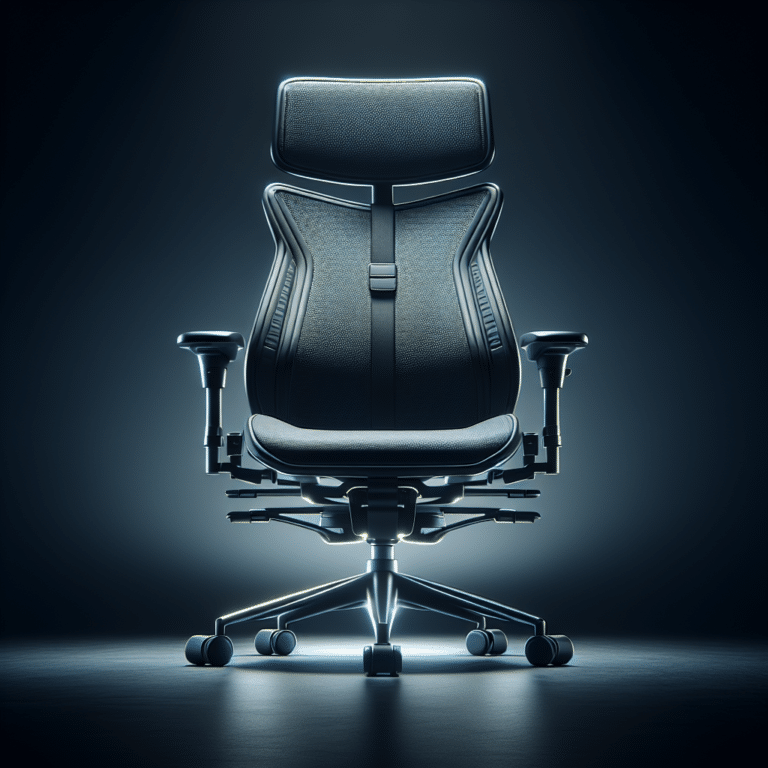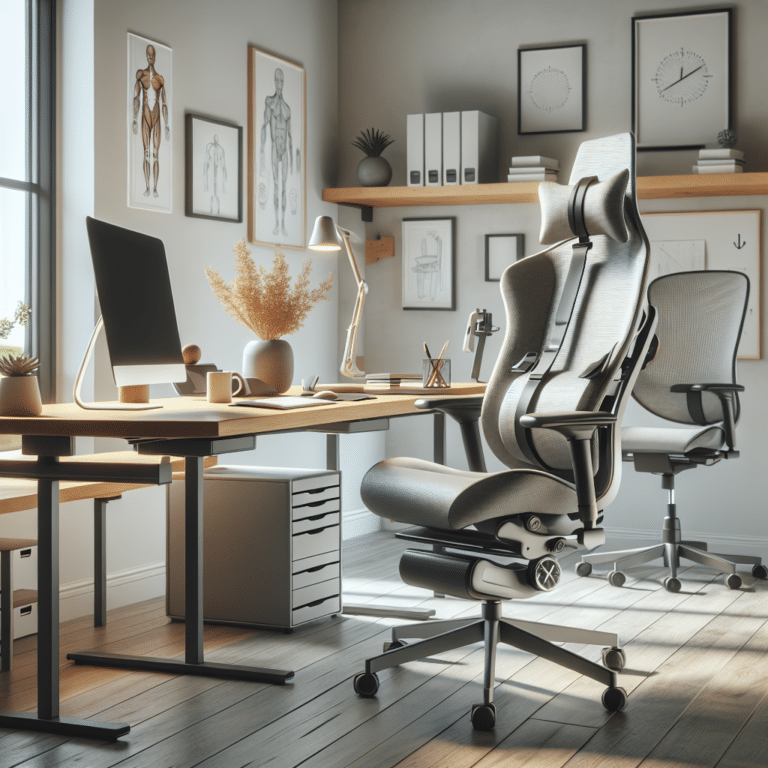The Ultimate Guide To Choosing The Right Ergonomic Chair
Are you tired of sitting in an uncomfortable chair all day? Do you experience back pain or stiffness after hours of work? Look no further! This ultimate guide will provide you with all the necessary information and tips to help you choose the right ergonomic chair. From adjustable features to proper lumbar support, discover how to optimize your comfort and well-being while sitting at your desk. Say goodbye to discomfort and hello to productivity with the perfect ergonomic chair.
Understanding Ergonomics
Ergonomics is the science of designing and arranging objects to fit the needs and capabilities of the people who use them. When it comes to chair design, ergonomics plays a crucial role in ensuring that seating provides the comfort, support, and adjustability necessary for optimal health and productivity. By understanding the principles of ergonomics, you can make informed choices when selecting a chair that will promote better posture, reduce the risk of musculoskeletal disorders, and enhance overall well-being.
Definition of Ergonomics
Ergonomics, in the context of chair design, refers to the systematic arrangement and adaptation of seating to fit the human body’s physical and cognitive requirements. It involves considering factors such as body dimensions, workplace environment, and duration of chair use to create chairs that promote comfort, productivity, and health. Ergonomic chairs are specifically designed to minimize strain on the body, reduce the risk of injury or discomfort, and provide support in all the right places.
Importance of Ergonomics in Chair Design
Ergonomics is of utmost importance in chair design due to the long hours people spend sitting, especially in office environments. Poorly designed chairs can lead to discomfort, fatigue, and even chronic musculoskeletal disorders such as back pain, neck pain, and repetitive strain injuries. Ergonomic chairs, on the other hand, are designed to support your body’s natural alignment, distribute weight evenly, and reduce strain on your muscles and joints. By promoting good posture and providing the necessary adjustability, ergonomic chairs significantly contribute to overall well-being and productivity.
Basic Ergonomic Principles for Seating
When it comes to seating ergonomics, several key principles should guide your understanding and decision-making process. These principles include:
Supportive Posture: An ergonomic chair should encourage proper posture by supporting the natural curves of your spine, particularly in the lumbar region. This helps maintain the spine’s neutral alignment and prevents slouching or excessive arching.
Adjustability: The ability to adjust various features of the chair, such as height, seat depth, and armrests, is essential in accommodating different body types and preferences. Adjustable chairs allow for customization to achieve optimal comfort and support.
Stable and Mobile Base: A good ergonomic chair should have a stable base to prevent tipping or wobbling. Additionally, it should provide smooth mobility and effortless swiveling, allowing you to move around your workspace without straining or exerting excessive effort.
Appropriate Seat Size: The seat should be wide and deep enough to accommodate the user comfortably. It should provide ample support for the thighs without putting excessive pressure on the back of the knees.
Durable and Quality Materials: The materials used in the chair’s construction should be durable, long-lasting, and able to withstand heavy use. High-quality materials ensure the chair remains supportive and comfortable for extended periods.
Assessing Your Needs
Before diving into the world of ergonomic chairs, it’s crucial to assess your individual needs. Understanding your physical requirements, evaluating your workplace environment, and determining the duration of your daily chair usage will help you make a well-informed decision when selecting the right chair for your specific needs. Let’s explore these aspects in detail.
Evaluating Your Physical Requirements
Consider your body type and any specific physical requirements you may have when choosing an ergonomic chair. Factors to consider include your height, weight, body dimensions, and any existing or potential musculoskeletal issues. These factors will influence the design features and adjustability options you should prioritize in your chair selection.
For example, taller individuals may benefit from chairs with extended backrests or adjustable headrests, while individuals with lower back pain might prioritize chairs with exceptional lumbar support. Understanding your physical requirements ensures that the chair you choose is well-suited to your unique body characteristics.
Considering Your Workplace Environment
The environment in which you work plays a significant role in determining the level of comfort and support you need from your chair. Consider factors such as the type of work you do, whether you primarily work at a desk or move around frequently, and the overall layout of your workspace.
For desk-bound office workers, an ergonomic chair with comprehensive adjustability features and ample lumbar support is essential to maintain good posture and minimize the risk of discomfort or injury. Meanwhile, individuals in more active work environments may require chairs with greater mobility and flexibility to accommodate their movements.
Determining the Duration of Daily Use
The amount of time you spend in your chair each day is another critical factor to consider. If you spend extended periods sitting, it is crucial to choose a chair that provides maximum comfort and support throughout the day. Chairs with superior padding and ergonomic design features can help alleviate pressure points and reduce the likelihood of discomfort or fatigue during prolonged use.
On the other hand, if you only use your chair for shorter durations or intermittently, you may have more flexibility in your selection. However, even occasional use warrants attention to ergonomic principles to ensure optimal comfort and minimize any potential negative effects on your well-being.
Key Features of an Ergonomic Chair
When shopping for an ergonomic chair, there are several key features to consider. These features encompass both the design elements that promote comfort and support, as well as the materials used in construction. Let’s explore the essential features that make an ergonomic chair stand out.
Adjustable Seat Height
Adjustable seat height is a crucial feature in an ergonomic chair that allows you to customize the chair’s height to your individual needs. To determine the correct seat height, ensure your feet are flat on the floor, with your thighs parallel to the ground and your knees bent at a 90-degree angle. The ability to adjust seat height ensures proper alignment of your knees, hips, and lower back, preventing discomfort and promoting good posture.
Lumbar Support
Proper lumbar support is vital in maintaining the curve of your lower back. An ergonomic chair with a contoured backrest or an adjustable lumbar support mechanism provides the necessary support to your lower back, preventing slouching and reducing strain on the lumbar region. This feature helps maintain a natural posture and minimizes the risk of developing lower back pain or other related issues.
Seat Depth and Width
The seat of an ergonomic chair should be deep and wide enough to support your entire buttocks and thighs comfortably. A seat that is too shallow or narrow can cause discomfort or restrict blood circulation to the legs. Ideally, the seat should have enough space for you to sit with your back against the backrest while still leaving a few inches of space between the back of your knees and the seat.
Backrest
The backrest of an ergonomic chair should provide ample support to the natural curves of your spine, particularly the lumbar region. Look for chairs with adjustable backrests that can be angled to fit your needs. Additionally, chairs with a breathable mesh backrest offer good ventilation and help regulate body temperature during prolonged sitting.
Armrests
Armrests are an important feature in an ergonomic chair, as they provide support to your arms and shoulders, reducing strain on these areas. Look for chairs with adjustable and padded armrests that can be adjusted to the appropriate height and width. The armrests should allow your arms to rest comfortably and be level with your desk or keyboard, preventing shoulder and neck tension.
Swivel and Mobility
A good ergonomic chair should have a smooth and effortless swivel mechanism, allowing you to easily turn and reach different areas of your workspace without straining or excessive twisting. Additionally, the chair should have sturdy casters that provide smooth mobility across different types of flooring. Swivel and mobility features contribute to overall ease of movement and accessibility in the workplace.
Material and Padding
The materials used in an ergonomic chair impact both its comfort and durability. Look for chairs with high-quality upholstery that provides adequate cushioning and support. Breathable materials such as mesh or fabric allow for better air circulation, preventing excessive perspiration and discomfort. Additionally, chairs with adequate padding ensure comfort during long hours of sitting.
Adjustability and Flexibility
Adjustability and flexibility are two crucial aspects of ergonomic chairs, allowing for customization to fit your unique body type and preferences. An ergonomic chair with adjustable features provides the ability to fine-tune the chair’s settings to achieve optimal comfort and support. Let’s delve deeper into the importance of adjustability, the types of adjustable features you might encounter, and how to adjust your chair for optimal comfort.
Importance of Adjustability
Adjustability in an ergonomic chair is essential as it allows you to tailor the chair’s settings to your specific body dimensions and needs. Each individual has unique proportions, and an adjustable chair enables you to find the perfect fit. By customizing the chair to your body, you can promote proper posture, reduce strain on your muscles and joints, and prevent discomfort or pain associated with prolonged sitting.
Types of Adjustable Features
Ergonomic chairs typically have various adjustable features that contribute to their overall flexibility. These features may include:
Seat Height: The ability to adjust the height of the chair allows you to find the optimal position for your feet to rest flat on the ground, maintaining proper leg and back alignment.
Seat Depth: Adjustable seat depth ensures that the seat provides adequate support for your thighs without placing undue pressure on the back of your knees.
Backrest Tilt: Chairs with an adjustable backrest tilt enable you to find the most comfortable angle for your back. This feature allows you to lean back slightly, relieving pressure on the spine and promoting a more relaxed position.
Lumbar Support: An adjustable lumbar support mechanism allows you to adjust the amount of support provided to your lower back. This feature ensures that the chair accommodates the natural curvature of your spine and helps prevent lower back discomfort.
Armrests: Adjustable armrests allow you to position the armrests at an appropriate height and width, providing support to your arms and reducing strain on your shoulders and neck.
Headrest: Some ergonomic chairs come with an adjustable headrest, which can be positioned to provide support for your neck and head, particularly during times when you may want to lean back and relax.
How to Adjust Your Chair for Optimal Comfort
Once you have identified the adjustable features of your ergonomic chair, it’s important to know how to adjust them properly for optimal comfort. Here’s a step-by-step guide:
Seat Height: Start by adjusting the chair’s height so that your feet are flat on the floor, with your thighs parallel to the ground and your knees bent at a 90-degree angle.
Seat Depth: Ensure that there is a few inches of space between the back of your knees and the seat’s edge. Adjust the seat depth accordingly to achieve this optimal position.
Backrest Tilt: Set the backrest tilt to a position that supports the natural curvature of your spine while providing a comfortable recline. Experiment with different angles and lock the backrest in a position that feels best for you.
Lumbar Support: Adjust the lumbar support feature to position the support cushion at the appropriate height for your lower back. The support should fit snugly into your lower back curve, providing gentle pressure without feeling uncomfortable or overly restrictive.
Armrests: Position the armrests so that your arms rest comfortably with your shoulders relaxed. Adjust both the height and width of the armrests to find the most natural and supportive position for your arms.
Headrest: If your chair has an adjustable headrest, position it to support your neck and head comfortably. The headrest should be positioned so that your head rests comfortably on it, without straining your neck or forcing your head forward.
Remember, everyone’s comfort preferences and body dimensions may differ, so it may take some trial and error to find the perfect adjustments that best suit you. Take the time to experiment with the various settings until you find the most comfortable and supportive configuration.
Identifying the Right Chair for Your Body Type
Choosing the right ergonomic chair involves matching your body dimensions with the chair’s size and adjustability options. Understanding different body dimensions, considering the chair size, and exploring the benefits of custom ergonomic chairs versus generic models will help you make an informed decision.
Understanding Different Body Dimensions
Body dimensions can vary significantly among individuals, and understanding your unique measurements is key to finding a chair that fits you properly. Important body dimensions to consider include:
Height: Your height determines the required seat height range to ensure proper alignment and support.
Weight: Chairs have different weight capacities, and it’s important to select one that can comfortably accommodate your weight without compromising stability or durability.
Body Shape: Different body shapes may benefit from specific chair designs. For example, individuals with wider hips may require chairs with wider seat widths for optimal comfort.
Matching Chair Size to Your Body
Once you understand your body dimensions, it’s important to find a chair that matches your size. Check the specifications and measurements provided by the manufacturer to ensure the chair’s seat height, depth, and width are appropriate for your body. A proper match will provide the necessary support and promote good posture, while an ill-fitting chair can lead to discomfort or even exacerbate existing musculoskeletal issues.
Custom Ergonomic Chairs versus Generic Models
While generic ergonomic chairs can cater to a wide range of body types, individuals with specific physical requirements may benefit from custom ergonomic chairs. Custom chairs are designed and built to meet the unique needs and body dimensions of an individual. They offer a higher level of adjustability and customization, ensuring the chair fits like a glove and supports your body in all the right places. Custom ergonomic chairs are especially beneficial for individuals with pre-existing musculoskeletal conditions or those with body dimensions that fall outside the range of standard chair sizes.
However, it is important to note that custom ergonomic chairs can be more expensive and may require a longer lead time for production. It’s essential to carefully weigh the benefits and costs before deciding which option is best for you.
Material and Build Quality
The materials used in the construction of an ergonomic chair significantly impact its durability, comfort, and overall quality. Assessing the materials used, understanding durability and longevity, and considering maintenance and cleaning requirements will help you make an informed decision.
Materials Used in Ergonomic Chairs
Ergonomic chairs are typically made using a combination of several materials, each serving a specific purpose. Common materials used include:
Frame: The frame of an ergonomic chair is typically made of metal, such as steel or aluminum, to provide strength and stability.
Upholstery: The upholstery of the chair can be made from various materials, including fabric, leather, or breathable mesh. Each material has its advantages and considerations, with fabric offering a wide range of options, leather providing durability and a sleek appearance, and mesh offering breathability and good ventilation.
Padding: Chairs with sufficient padding ensure comfort during prolonged sitting. High-density foam is commonly used for cushioning, providing support and maintaining its shape over time.
Base and Casters: The base of an ergonomic chair is usually made of durable materials such as heavy-duty plastic, steel, or aluminum. The casters, or wheels, should be sturdy and suitable for the type of flooring in your workplace, ensuring smooth mobility and stability.
Durability and Longevity
Choosing an ergonomic chair made of durable materials is crucial for long-term usage. Investing in a chair that is built to last will save you from the hassle and expense of frequent replacements. Look for chairs with robust construction, reinforced frames, and high-quality materials that can withstand the rigors of daily use.
Pay attention to customer reviews and feedback to gauge the chair’s longevity. Chairs that come with extended warranties typically indicate the manufacturer’s confidence in the chair’s build quality.
Maintenance and Cleaning
Regular maintenance and cleaning are essential for preserving the condition and longevity of your ergonomic chair. Different materials may require different cleaning methods, so always refer to the manufacturer’s guidelines for proper care. Here are some general maintenance tips:
Regular Cleaning: Wipe down the chair regularly to remove dust, dirt, and spills. Use a soft cloth or sponge dampened with mild soap and water. Avoid using abrasive cleaners or harsh chemicals that may damage the upholstery or other components.
Spot Cleaning: Treat stains or spills immediately to prevent them from setting into the fabric. Blot the affected area gently with a clean cloth or sponge and a mild detergent solution. Avoid scrubbing vigorously, as this may damage the fabric or spread the stain.
Upholstery Protection: Consider using fabric protectors or stain-resistant treatments to repel liquids and prevent stains from setting in. These treatments create a barrier that makes cleaning spills easier.
Routine Inspections: Regularly check the chair for loose screws, bolts, or any signs of wear and tear. Tighten screws and bolts as needed and replace any damaged or worn-out components promptly.
Proper maintenance and timely repairs or replacements ensure that your chair remains in excellent condition, maximizing its lifespan and your comfort.
The Role of Aesthetics in Ergonomic Chairs
While the primary focus of ergonomic chairs is functionality, aesthetics also play a vital role in office design. Balancing form with function, integrating ergonomic chairs in office design, and considering color psychology when selecting a chair can enhance the overall workspace experience.
Balancing Form with Function
Ergonomic chairs have evolved over time to incorporate sleek, modern designs that blend well with different office aesthetics. Employers and designers are increasingly realizing the importance of ergonomic chairs that not only provide comfort but also enhance the overall appearance of the workspace.
Balancing form with function involves selecting chairs that not only meet ergonomic standards but also align with the company’s brand identity and interior design theme. Combining aesthetics with ergonomic principles creates a visually appealing and harmonious workspace that promotes both well-being and productivity.
Integrating Ergonomic Chairs in Office Design
Integrating ergonomic chairs seamlessly into office design involves choosing chairs that complement the overall aesthetic of the workspace. The chairs should not disrupt the visual harmony or stand out in a jarring way. Consider factors such as color schemes, textures, and materials in the workspace when selecting chairs that blend well with the existing office furniture and decor.
Additionally, ergonomic chairs should be considered as part of a holistic approach to office ergonomics. By incorporating ergonomic solutions into the entire office design, from adjustable desks to proper lighting and layout, the workplace can foster a supportive and wellness-oriented environment.
Color Psychology and Chair Selection
Color psychology plays a significant role in influencing our emotions, mood, and productivity. When selecting an ergonomic chair, consider the impact of different colors on the overall ambiance of your workspace. While personal preferences may vary, here are some general associations with colors:
Blue: Often associated with calmness and productivity, blue can create a sense of tranquility and focus in the workplace.
Green: Green is commonly associated with nature and promotes a feeling of relaxation, balance, and harmony.
Black: Black exudes elegance, sophistication, and authority. However, an all-black color scheme may create a more formal or serious atmosphere.
White: White is often associated with cleanliness, simplicity, and neutrality. It can create a sense of spaciousness and brightness in the workspace.
Red: Red is a bold and energizing color that can stimulate creativity and intensity. However, it may also induce feelings of restlessness or agitation in some individuals.
Neutral or Earth Tones: Neutral colors such as beige, gray, or earth tones can provide a versatile backdrop in the workspace, promoting a sense of calmness and stability.
Consider the overall ambiance and mood you want to achieve in your workspace when selecting the color of your ergonomic chair. Remember that personal preferences and cultural contexts can also influence the impact of colors, so choose a color that resonates with you and creates a positive environment for your workday.
Health Benefits of Using an Ergonomic Chair
Investing in an ergonomic chair offers numerous health benefits that go beyond mere comfort. By prioritizing your well-being and providing the necessary support, ergonomic chairs can significantly improve your overall health and posture. Let’s delve into the specific health benefits of using an ergonomic chair.
Reducing the Risk of Musculoskeletal Disorders
One of the primary benefits of an ergonomic chair is its ability to reduce the risk of musculoskeletal disorders. Prolonged sitting in poorly designed chairs can lead to various issues, including back pain, neck pain, and repetitive strain injuries. Ergonomic chairs are specifically crafted to support the natural alignment of your spine, minimize strain on your muscles and joints, and alleviate pressure on particular body parts.
By promoting good posture and providing targeted support to the lumbar region and other critical areas, ergonomic chairs help reduce the risk of musculoskeletal disorders and related discomfort.
Improving Posture
Sitting for extended periods can take a toll on your posture, leading to slouching, rounding of the shoulders, and misalignment of the spine. Ergonomic chairs are designed to counteract these poor posture habits by providing the necessary support and promoting a more upright position.
With features like adjustable lumbar support, contoured backrests, and proper seat depth, ergonomic chairs encourage a natural, aligned posture. This helps prevent the development of bad habits and contributes to better overall posture, both in and out of the chair.
Enhancing Blood Circulation
Sitting for prolonged periods can impede blood circulation, particularly in the lower extremities. Ergonomic chairs address this issue by allowing for proper weight distribution and avoiding compression on blood vessels.
Ergonomic chairs with adjustable seat height ensure that your feet are firmly planted on the ground, enabling unrestricted blood flow to the legs. Additionally, chairs with contoured seat edges or waterfall seat designs can alleviate pressure on the back of the thighs, further enhancing blood circulation.
Minimizing Workplace Injuries
Ergonomic chairs play a crucial role in minimizing workplace injuries caused by poor seating arrangements. Strains, sprains, and discomfort associated with prolonged sitting can lead to decreased productivity and prolonged recovery periods.
By providing proper support, adjustability, and comfort, ergonomic chairs help prevent workplace injuries. They reduce the risk of strains and sprains by promoting appropriate posture, contributing to better overall well-being and reducing absenteeism due to pain or discomfort.
Budget Considerations
When it comes to purchasing an ergonomic chair, considering your budget is an important factor. Understanding price ranges, the value of investing in quality versus cutting costs, and performing a cost-benefit analysis of ergonomic chairs will aid you in making a budget-conscious decision.
Understanding Price Ranges
Ergonomic chairs are available at various price points, ranging from budget-friendly options to high-end, luxury models. The price of a chair often reflects the build quality, adjustability options, and additional features it offers. Chairs at the higher end of the price spectrum typically come with more advanced ergonomic features, greater customization options, and longer-lasting durability.
However, it is possible to find affordable ergonomic chairs that offer good value for the price. Research and compare options within your budget range, keeping in mind the essential features that align with your specific needs.
Investing in Quality vs. Cutting Costs
When it comes to ergonomic chairs, it is generally advisable to invest in quality rather than simply opting for the cheapest option available. High-quality ergonomic chairs offer superior durability, better adjustability, and increased comfort compared to their lower-quality counterparts.
Investing in a well-constructed ergonomic chair ensures that it will last for years, providing long-term benefits to your health and well-being. While the initial cost may be higher, the cost per year of use, as well as the long-term health benefits, outweigh the initial investment.
Cutting costs and opting for a cheap chair with minimal adjustability and inadequate support may lead to discomfort, increased risk of musculoskeletal issues, and the need for an early replacement. It is important to find a balance between affordability and quality, prioritizing features that directly impact your comfort and overall health.
Cost-Benefit Analysis of Ergonomic Chairs
Performing a cost-benefit analysis can help you evaluate the value and long-term benefits of investing in an ergonomic chair. Consider the initial cost of the chair compared to the additional productivity, improved well-being, and potentially reduced healthcare costs associated with using an ergonomic chair.
A higher-priced ergonomic chair may provide features and support that directly contribute to your overall comfort and health, potentially reducing the likelihood of developing musculoskeletal issues or other workplace-related ailments. By assessing the long-term benefits and potential cost savings, you can make an informed decision that aligns with your budget and well-being goals.
Staying Informed: Latest Trends in Ergonomic Chairs
The field of ergonomic chairs continues to evolve, with new designs and innovations constantly being introduced. Staying informed about the latest trends in ergonomic chairs can help you stay ahead of the curve and make informed decisions when choosing a chair that meets your needs. Let’s explore the emerging designs and innovations, ongoing ergonomic research, and the future of workplace seating.
Emerging Designs and Innovations
As awareness of the importance of ergonomic seating grows, manufacturers are continuously introducing new designs and innovations to enhance the user experience. Some emerging trends in ergonomic chair design include:
Dynamic Seating: Dynamic seating promotes movement while sitting, allowing the chair to adapt to the user’s movements and encourage active sitting. This can improve blood circulation, reduce muscle fatigue, and promote better posture.
Smart Chairs: Smart chairs incorporate technology to monitor and adjust various chair settings based on the user’s body movements and preferences. These chairs can track sitting patterns, provide feedback on posture, and make real-time adjustments for optimal comfort and support.
Sustainable Materials: With a growing focus on sustainability, manufacturers are exploring the use of eco-friendly materials in ergonomic chair construction. This includes materials made from recycled or sustainable sources, as well as chairs designed for easy disassembly and recycling at the end of their lifespan.
Wellness-Centric Designs: Some chairs are designed to go beyond basic ergonomics and incorporate wellness-focused features. These chairs may include features such as built-in workout options, posture-correction reminders, or integrated resistance systems to promote physical activity while sitting.
Ergonomic Research and New Findings
Ongoing research in the field of ergonomics continues to shed light on the impact of seating on overall health and well-being. Researchers and experts are exploring various aspects, including the effects of movement during sitting, the relationship between posture and productivity, and the long-term impact of sedentary behavior.
New findings from these studies can further inform the design of ergonomic chairs and help users make more informed choices. Staying up to date with the latest research can equip you with valuable insights and enable you to make decisions that align with current best practices in ergonomic seating.
The Future of Workplace Seating
The future of workplace seating will likely involve a greater emphasis on tailored solutions that cater to individuals’ unique needs. Custom ergonomic chairs, utilizing advanced technology and data-driven solutions, may become more prevalent. These chairs could offer personalized support, adapt to individual body movements, or even provide real-time feedback to optimize comfort and productivity.
Moreover, the convergence of ergonomics and technology may lead to the integration of ergonomic seating with augmented reality (AR) or virtual reality (VR) systems. Such innovations may provide immersive and interactive solutions that promote movement, engagement, and well-being in the workplace.
As workplaces evolve and the understanding of ergonomics advances, the future of workplace seating holds exciting possibilities. Staying informed about emerging trends and actively seeking out new research findings will help you navigate this evolving landscape and select chairs that meet your unique needs well into the future.
In conclusion, understanding ergonomics and its role in chair design is essential for selecting the right ergonomic chair that caters to your individual needs. By evaluating your physical requirements, considering your workplace environment, and determining the duration of your chair usage, you can make informed decisions when choosing an ergonomic chair. Remember to prioritize features such as adjustability, lumbar support, seat depth, backrest, armrests, and mobility to ensure optimal comfort and support.








